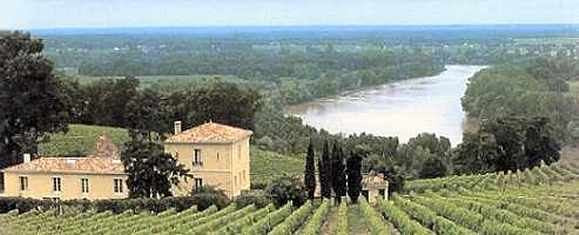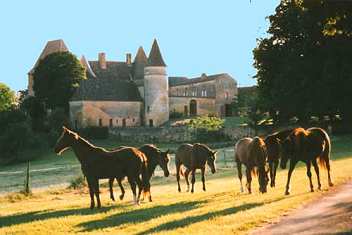The Southwest of France
 "France" of
the 16th century (and even today) is not a homogenous country culturally,
linguistically, or even politically. Although at this time "France" recognizes
a single king, different provinces have long histories of separate laws,
parliaments, jurisdictions, customs, languages, and powerful feudal magnates.
There is a particularly noticable cultural divide that sweeps through the
county along an arc that is best delimited by the Loire River. North is
the land of the historic Franks, French-speaking, Gallo-Germanic in heritage,
where the King of France has his ancestral demesne. South is the land of
the Gauls, Visigoths, and ancient Roman law, speakers of various Occitan
dialects (Gascon, Provencal, Dauphinois, Catalan, and so on), the land
of troubadours and heretics. The south was essentially conquered
by the north during the Albigensian crusades in the 13th century, but retained
a very distinct local identity, relatively far from central control.
"France" of
the 16th century (and even today) is not a homogenous country culturally,
linguistically, or even politically. Although at this time "France" recognizes
a single king, different provinces have long histories of separate laws,
parliaments, jurisdictions, customs, languages, and powerful feudal magnates.
There is a particularly noticable cultural divide that sweeps through the
county along an arc that is best delimited by the Loire River. North is
the land of the historic Franks, French-speaking, Gallo-Germanic in heritage,
where the King of France has his ancestral demesne. South is the land of
the Gauls, Visigoths, and ancient Roman law, speakers of various Occitan
dialects (Gascon, Provencal, Dauphinois, Catalan, and so on), the land
of troubadours and heretics. The south was essentially conquered
by the north during the Albigensian crusades in the 13th century, but retained
a very distinct local identity, relatively far from central control.
In the 16th century, this southern
crescent
also corresponds to a very strong concentration of "the
Reform" -- the French Protestants known popularly as Huguenots. From
1562 to 1598 France suffered a state of continuous civil war known as the
Wars
of Religion between Catholics and Protestants. The war was marked by
only a handful of pitched field battles, but a state of seige, skirmish,
and low-intensity guerilla war was endemic in many areas, especially the
south. The Southwest was also significant because it was the ancestral
power base of Henri de Navarre,
king of Navarre, vicomte de Bearn, governor of Guyenne,  leader
of the Protestant party, and after 1589 King of France. In 1600 the country
is at peace and the king, now ensconced in Paris and never to return to
his homeland, is energetically encouraging rebuilding of industry, trade,
and agriculture which had all been disrupted by years of war.
leader
of the Protestant party, and after 1589 King of France. In 1600 the country
is at peace and the king, now ensconced in Paris and never to return to
his homeland, is energetically encouraging rebuilding of industry, trade,
and agriculture which had all been disrupted by years of war.
Jehan's particular corner of the Southwest is along the Dordogne
River, in the region of the Perigord,
near the home of Michel de Montaigne the famous essayist, the great wine
capital of Bordeaux, and the chateaux of the Hundred Years War. The cuisine
of this area was celebrated at a great Festin
a year ago. As the Aquitaine, this region was under English control through
most of the Hundred Years war. The English taste for fine claret is an
ancient one, and the Bordeaux-English wine trade has been going on for
centuries. In the 16th century, there are two great wine fairs every year,
in October and February, where the city of Bordeaux grows by an estimated
7,000 English who descend upon it for the wine trade. The English have
their own quarter of town, and roam around in the winter to other southern
ports trading wool for woad and other southern products before returning
home.

This chateau near Ste. Foy-la-Grande greatly resembles the sort
of country manor that Jehan lives in.
 leader
of the Protestant party, and after 1589 King of France. In 1600 the country
is at peace and the king, now ensconced in Paris and never to return to
his homeland, is energetically encouraging rebuilding of industry, trade,
and agriculture which had all been disrupted by years of war.
leader
of the Protestant party, and after 1589 King of France. In 1600 the country
is at peace and the king, now ensconced in Paris and never to return to
his homeland, is energetically encouraging rebuilding of industry, trade,
and agriculture which had all been disrupted by years of war.
 "France" of
the 16th century (and even today) is not a homogenous country culturally,
linguistically, or even politically. Although at this time "France" recognizes
a single king, different provinces have long histories of separate laws,
parliaments, jurisdictions, customs, languages, and powerful feudal magnates.
There is a particularly noticable cultural divide that sweeps through the
county along an arc that is best delimited by the Loire River. North is
the land of the historic Franks, French-speaking, Gallo-Germanic in heritage,
where the King of France has his ancestral demesne. South is the land of
the Gauls, Visigoths, and ancient Roman law, speakers of various Occitan
dialects (Gascon, Provencal, Dauphinois, Catalan, and so on), the land
of troubadours and heretics. The south was essentially conquered
by the north during the Albigensian crusades in the 13th century, but retained
a very distinct local identity, relatively far from central control.
"France" of
the 16th century (and even today) is not a homogenous country culturally,
linguistically, or even politically. Although at this time "France" recognizes
a single king, different provinces have long histories of separate laws,
parliaments, jurisdictions, customs, languages, and powerful feudal magnates.
There is a particularly noticable cultural divide that sweeps through the
county along an arc that is best delimited by the Loire River. North is
the land of the historic Franks, French-speaking, Gallo-Germanic in heritage,
where the King of France has his ancestral demesne. South is the land of
the Gauls, Visigoths, and ancient Roman law, speakers of various Occitan
dialects (Gascon, Provencal, Dauphinois, Catalan, and so on), the land
of troubadours and heretics. The south was essentially conquered
by the north during the Albigensian crusades in the 13th century, but retained
a very distinct local identity, relatively far from central control.
